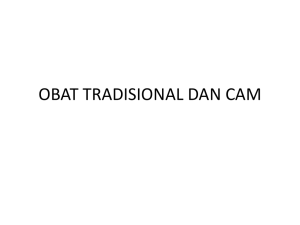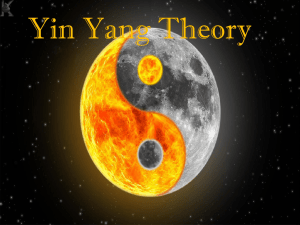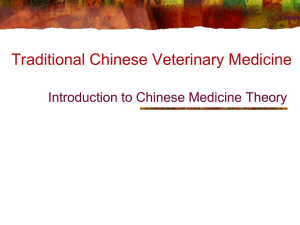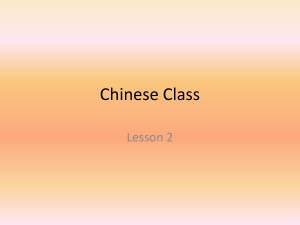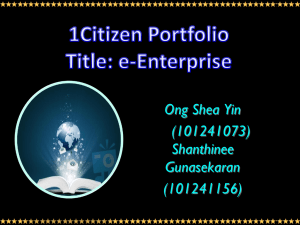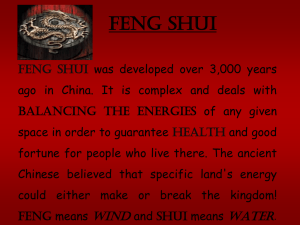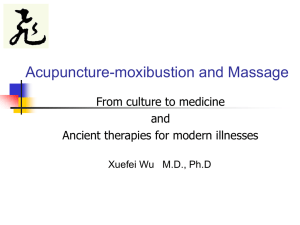points - Acupuncture Massage College
advertisement
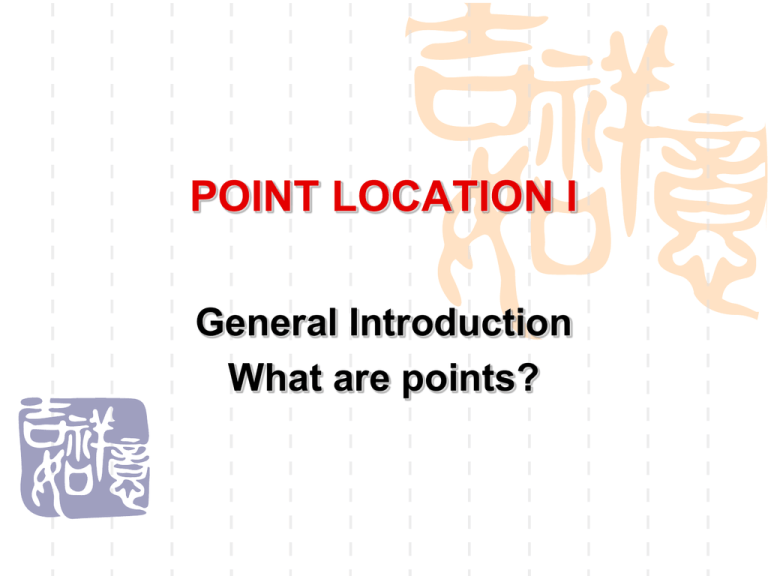
POINT LOCATION I General Introduction What are points? What are Acupuncture Points Traditional Chinese Perspective Specific areas on the body surface (skin) by which Qi and Blood are transported Reflect the functional condition of the body Capable of receiving stimulation to prevent and treat disease What are Acupuncture Points Modern Scientific Perspective Neurological Pathways: Studies show that acupuncture stimulate all parts of the nervous system. Electrical Characteristics: Measuring the electrical resistance or the current flowing across the acupoints with a pre-determined voltage. Studies show that acupuncture points have a lowered electrical resistance or an increase in current. What are Acupuncture Points Modern Scientific Perspective Radio-Active Tracer Studies: The use of radioactive tracers to study acupuncture points and meridians shows that they are neither vascular nor lymphatic in origin, but are related to connective tissues interstitial spaces which would constitute a preferred ionic pathway. The History of Acupuncture Points Origins 4000—8000 years ago Painful, tender areas that when pressed produce relief Reactions on areas of the body during disease Anatomical landmarks: Blood vessels, ligaments, tendons & muscles, bone Development & the Historical Record Originated as early as in the clan commune period of the primitive society. Acupuncture instruments were made of stone and were named “bian stone.” Needles were made of stone. To incise abscess, drain pus and let blood out for therapeutic purposes. 3,000 years ago in the Shang Dynasty The hieroglyphs of acupuncture and moxibustion appeared in the inscriptions on bones and tortoise shells. Development & the Historical Record Eleven vessels of foot and hand and Eleven vessels of yin and yang (before the Yellow Emperor’s Internal Classic) Records 6 foot vessels and 5 hand vessels; Records areas for moxibustion and blood-letting with stone needles. Development & the Historical Record Fifty-two Prescriptions (Wu Shi Er Bing Fang) (before the Yellow Emperor’s Internal Classic) Three tombs of early Western Han Dynasty were excavated at Mawangdui in the eastern outskirts of Changsha in 1972. Silk manuscript Prescriptions for Fifty-two Diseases found in Tomb No. 3, 52 diseases were recorded together with over 100 specifications of diseases. With over 280 prescriptions and 240 drugs recorded in the book, it is the earliest prescription book ever found in China. It recorded areas on the body for moxibustion and bloodletting. The General Theory & Classification of Points Relationship between Points and Viscera and Channels-Collaterals Viscera-channels-points Channels and Collaterals (Jing Luo) Channels (Meridians ) are the carriers for qi/blood. Jing = channels. Geographical connotations: like water channel or pathway. Bigger branches, like large rivers. Run at a relatively deep level, connect with zangfu characteristics: 1. main trunks 2. usually run longitudinally 3. usually go very deep inside body. 4. will connect to interior organs. Twelve Primary Channels ---- 十二正经 Twelve Divergent Channels ---- 十二经别 Luo = “to attach” or “net”. Collaterals. Interlock the channels. Smaller tributaries, like creeks. Run more superficially. characteristics: 1.branches 2.run transversely, i.e., to all other directions not just longitudinally 3.more superficial. 4. do not directly connect to interior organs. Fifteen Luo-Connecting collaterals ---- 十五络 Minute Collaterals ---- 孙络 12 regular channels 6 yang channels Yang channels are connected to yang (fu) organ Located primarily in a yang area of the body (Exception: stomach channel) § 3 hand yang channels (hand channels end or begins at a finger and most of the channel runs on the upper limb) § 3 foot yang channels (foot channels end or begin at a toe and most of channel runs on lower limb) 6 yin channels Yin channels are connected to yin (zang) organ Located primarily in a yin area of the body. § 3 hand yin channels (hand channels end or begins at a finger and most of the channel runs on the upper limb) § 3 foot yin channels (foot channels end or begin at a toe and most of channel runs on lower limb) Three Hand Yin Channels: Hand Tai-Yin Lung Channel Hand Jue-Yin Pericardium Channel Hand Shao-Yin Heart Channel Three Hand Yang Channels: Hand Yang-Ming Large Intestine Channel Hand Shao-Yang San-Jiao Channel Hand Tai-Yang Small Intestine Channel Three Foot Yin Channels: Foot Tai-Yin Spleen Channel Foot Jue-Yin Liver Channel Foot Shao-Yin Kidney Channel Three Foot Yang Channels: Foot Yang-Ming Stomach Channel Foot Shao-Yang Gallbladder Channel Foot Tai-Yang Urinary Bladder Channel The eight extraordinary vessels Governing Vessel ---- Du Mai Conception / Directing Vessel ---- Ren Mai Thoroughfare / Penetrating Vessel ---- Chong Mai Belt / Girdling Vessel ---- Dai Mai Yin-Heel / Yin-Motility Vessel ---- Yin-Qiao Mai Yang-Heel / Yang-Motility Vessel ---- Yang-Qiao MaiYin-Linking Vessel ---- Yin-Wei Mai Yang-Linking Vessel ----Yang-Wei Mai Twelve Sinew Channels(十二经筋):Smaller channels gathering around joints/sinews. Twelve Cutaneous Regions (十二皮部):12 of them. Very superficial, shallow, cover where 12 regular Meridians pass through. Aren’t a line or meridian, but regions Please note: 14 Channels: The Twelve Primary Channels plus Ren Mai and Du Mai are called ‘14 Channels’. They are the major channels throughout the body and have been used widely in clinical practice. The General Theory & Classification of Points Classification of Points Jing or “channel” points (Acupuncture Points of the Fourteen Channels) Characteristics: Have a pertaining channel, name, and specific location Number: There are 361 Jing points in total. The General Theory & Classification of Points Classification of Points Extra points Characteristics: Have a name and a specific location but no pertaining channel. Classification: Extra points that are situated on the course of channels; Extra points that are not situated on the course of the channels. Number: 45 Extra points accepted by the WHO; historically the number varies from 20-200. The General Theory & Classification of Points Classification of Points Ashi points Characteristics: Having no pertaining channel, no name and no specific location. Number: Countless. Nomenclature of Points Point Names Reflecting Naturalistic Imagery Quchi (LI 11, Crooked Pond) Shaohai (HT 3, Young Sea) Hegu (LI 4, Joining Valleys) Taiyuan (LU 9, Supreme Abyss) Bearing Analogy to Animals Yuji (LU 10, Fish Border) Dubi (ST 35, Calf Nose) Yuyao (Extra Point, Fish Waist) Nomenclature of Points Point Names Bearing Analogy to Architectural Structures Shenmen (HT 7, Spirit Gate) Neiting (ST 44, Inner Courtyard) Jianjing (GB 21, Shoulder Well) Fengshi (GB 31, Wind Market) Bearing Analogy to Astronomical in Meteorological Phenomena Riyue (GB 24, Sun and Moon) Taibai (SP 3, Venus) Fengchi (GB 20, Wind Pool) Taiyang (Extra Point, Supreme/Sun Yang) Nomenclature of Points Points Named According to Anatomical Terms Jianyu (LI 15, Shoulder Corner) Ruzhong (ST 17, Middle of Breast) Erjian (Extra Point, Tip of Ear) Their Therapeutic Properties Jingming (BL 1, Brighten Eyes) Yingxiang (LI 20, Welcome Fragrance) Anmian (Extra Point, Peaceful Sleep) Nature of Points According to the Yin-Yang & Five Elements Schemes Points and Yin-Yang Based on channels: points situated on the yang channels are more yang in nature while those situated on the yin channels are more yin in nature. Based on locations: points located in the yang portion of the body are yang points while located in the yin portion of the body are yin points. Nature of Points According to the Yin-Yang & Five Elements Schemes Points and the Five Elements All points have a general Five Element nature corresponding to the Five Element nature of the channels. In other words, since the Five Element nature of the channels corresponds to the Five Element nature of their pertaining viscera or bowels, then the Five Element nature of the points corresponds the Five Element nature of their pertaining channels. Therefore: Nature of Points According to the Yin-Yang & Five Elements Schemes Points and the Five Elements points on the Lung channel and the Large Intestine channel belong to Metal points in the Stomach channel and the Spleen channel belong to Earth points on the Heart channel and the Small Intestine channel belong to Fire points on the Kidney channel and the Bladder channel belong to Water points on the Liver channel and the Gallbladder channel belong to Wood Nature of Points According to the Yin-Yang & Five Elements Schemes Points and the Five Elements In addition, the Five-Shu points are endowed with the nature of Five Elements: For the yang channels: Jing-well —Metal, Ying-spring—Water, Shu-stream—Wood, Jing-river—Fire, He-sea–Earth For the yin channels: Jing-well —Wood, Ying-spring—Fire, Shustream—Earth, Jing-river—Metal, He-sea–Water POINT LOCATION I Function of points Function of Points Transport Qi and Blood points--collaterals--channels--Zangfu Function of Points Reflect dysfunction of the body Abnormal sensation: tender, sensitivity, cold, warm Change of shape: node, rash, strip-like things, prominent, depression, swelling Abnormal color: red, white, green-blue, purple Change of electrical properties: especially at the Yuan-Source and Jing-Well points Change of the skin temperature: higher or lower Function of Points Assist in diagnosis Danlang Xue (Cholecystitis) , Lanwei Xue (Appendicitis) Function of Points Examination methods Inspection: color, rashes, change of shape, decortication Inquiry: special sensation: pain, numbness, sore, swelling, cold, hot Palpation: pressing Measurement with instrument: electrical resistance, electrical potential, temperature Function of Points Prevention and treatment of disease Prevention of disease: ST 36, RN 4, 6, 8, DU 4, DU 14, LI 4 Treatment of disease: WHO acknowledges that 43 different diseases can be effectively treated with acupuncture Therapeutic Properties of Points Local and adjacent therapeutic effects •A common therapeutic effect for all kinds of points (Jing points, Extra points, Ashi points). Remote therapeutic effects •A common therapeutic effect for all Jing-points and some Extra points, especially the specific points. Therapeutic Properties of Points Specific therapeutic effects Jing-well points for acute disorders Ying-Sping points for fever Back Shu: Zang Disorders Front-Mu points and Lower He-Sea points for disorders of the Fu-organs DU 14 and DU 20: fever, mental problems GB20, Taiyang: Head disorders ST 36, RN 4: general deficiency of the body ST 38: Shoulder Problems BL 67: malposition of the fetus (moxibustion during third trimester) RN 9 & KI 7: Regulate water passageways, Edema ST 36: increase the secretion of the gastric acid SP 4, PC 6 and ST 34: inhibit the secretion of gastric acid LI 4 and ST 44: toothache SP 1: Bleeding Disorders Therapeutic Properties of Points Specific therapeutic effects LI 11: Hypertension BL 18: lower the level of blood sugar BL 17: increase the level of blood sugar, blood diseases of TCM BL 40: Skin Diseases BL 57 and Erbai: Hemorrhoids PC 6: Nausea HT 6, KI 6: Night Sweating SI 1: Absence of lactation DU9: Jaundice DU 10: Lymphangitis DU 14, Erjian: Fever Anmian: Insomnia Dingchuan: Asthma Shiqizhuixia: Painful menses POINT LOCATION I Specific Points Specific Points “Points with Specific Therapeutic Effects.” Specific Points 1. 2. 3. 4. 5. 6. 7. 8. Five shu points Yuan-source points Luo-Connecting points Back-shu points and front-mu points Xi-cleft points Eight influential points lower He-sea points Eight confluent points and the intersecting points. Five-Shu Points “Transporting Points” Definition and Names of the Five-Shu Points: Is the place where the Qi flows like a river from the extremity to the elbows and knees. 1. Jing-Well: Qi Emanates 2. Ying-Spring: Qi Glides 3. Shu-Stream: Qi Pours 4. Jing-River: Qi Flows 5. He-Sea: Qi Enters Inwards Distribution of the Five-Shu Points: Below the Elbow and knee joints Yuan-Source Points 原穴 Definition: The points where the Yuan Qi (Original Qi) of the Zang-fu organs “Surfaces, Resides or Lingers and Passes Through.” The Yuan-Source Points of the Yin Channels are also the Shu-Stream Points of the Yin Channels. Specific Therapeutic Effects: Treating disease of the corresponding Zang-fu organs Assist in making diagnosis: “Disease will appear at the Yuan-Source Points” GB 40 for cholecystitis HT 7 for coronary heart disease Luo-Connecting Points 络穴 Definition The points connecting two channels exterior-interiorly related The Luo-Connecting Channels separate from the primary channels. Specific Therapeutic Effects: Treating disorders of their pertaining channels and Zang-Fu organs Treating disorders of their interiorly-exteriorly related channels or Zang-fu organs. For example, LU7 is used to treat toothache and headache Treating disorders of their corresponding collaterals. For example, HT5 is used to treat fullness of the chest (excess) and dysphasia (deficient) Chronic Disease (Same Channel) Mental and emotional disorders Xi-Cleft Points 郄穴 Definition The point is where Qi and blood of channels “Gather and Plunge Deeper into the Body.” Xi-Cleft Points Specific Therapeutic Effects: Xi cleft-points: severe and intractable disease, especially acute ones Xi-cleft of the Yin Channels: Blood Disorders Xi-cleft of the Yang Channels: Acute Disorders and Pain Disorders Back-Shu Points 背俞穴 Definition Points on the back where the Qi of Zang-Fu organs is infused (Shu means “to Transport” + Zang Fu name) Classic of Difficulties: “Disease of Yin, treat the Yang” Back-Shu Points Specific Therapeutic Effects: Disorders of corresponding Zang-Fu organs Disorders of the tissues and orifices related to their corresponding Zang-Fu organs Assisting diagnosis making: Points lie relatively at the same anatomical level as the pertaining Zang-Fu Organ. Front-Mu Points 募穴 Definition Points on the chest and abdomen where the Qi of the Zang-Fu organs is “Infused and Converged” or “Gather and Concentrate” on the anterior surface of the body. Close to related organs Front-Mu Points Specific Therapeutic Effects Disorders of corresponding Zang-Fu organs, especially the Fu-organs “Needling can deeply reach the Fu Organs.” Point Combination Combined with the Back-Shu points Combined with the He-Sea points Lower He-Sea Points 下合穴 Definition •Six points on the lower extremities where the Qi from the six Fu Organs communicates with the three foot-yang channels. •The three-foot yang channels Lower He-Sea Points are the same as the HeSea Points Lower He-Sea Points Specific Therapeutic Effects: Disorders of the six Fu-organs Point Combination Combined with the Front-Mu points Eight Influential Points 八会穴 “8 Hui Points” Definition The Qi of the Zang-organs, Fu-organs, Qi, blood, sinews, vessels, bone and marrow is converged. Eight Influential Points Specific Therapeutic Effects: Disorders of corresponding viscera or tissues RN 12: stomachache, abdominal distention, borborygmus, vomiting, dysentery, and jaundice, especially the disease of the stomach and intestines Eight Influential Points LR 13: abdominal distention, borborygmus, hypochondriac pain, and cold pain of the back, especially the disease of the liver and spleen GB 34: weakness, numbness and/or pain of the lower limbs, hypochondriac pain, bitter taste and vomiting GB 39: stroke, paralysis, pain of the lower limbs Eight Influential Points BL 11: pain of the scapulae, neck, and back BL 17: disorders of blood, such as anemia and purpura RN 17: oppression of the chest, asthma, belching, cough, pain of the chest and heart LU 9: chest Bi-syndrome, pain of the heart, asthma Eight Confluent Points (“Confluence Points of the Eight Vessels”) 八脉交会穴 Definition Eight points where Qi of the eight extra vessels communicates with the twelve regular channels. Eight Confluent Points Specific Therapeutic Effects: Disorders of corresponding: Regular Channels Extra Vessels Eight Confluent Points Point Combination Combination of the upper and the lower: SP 4 + PC 6 SJ 5 + GB 40 SI 3 + BL 62 LU 7 + KI 6 Crossing Points 交会穴 Definition Points where two or more channels meet Origin The Yellow Emperor’s Internal Classic Systematic Classic of Acupuncture and Moxibustion Crossing Points Around 103 crossing points are recorded in the ancient medical works. Examples include: ST 7 (Xiaguan): ST+GB ST 30 (Qichong): ST+Chong vessel SP 6 (Sanyinjiao): SP+LR+KI GB 20 (Fengchi): GB+Yang Linking Vessel RN 4 (Guanyuan): RN+SP+LR+GB RN 3 (Zhongji): RN+SP+LR+GB RN 2 (Qugu): RN+LR RN 1 (Huiyin): RN+DU+Chong DU 20 (Baihui): DU+BL; DU+three hand and foot yang channels DU 16 (Fengfu): DU+Yang Linking Vessel DU 14 (Dazhui): DU+three hand and foot yang channels Crossing Points Specific Therapeutic Effects: Disorders of the channels crossing at these points

